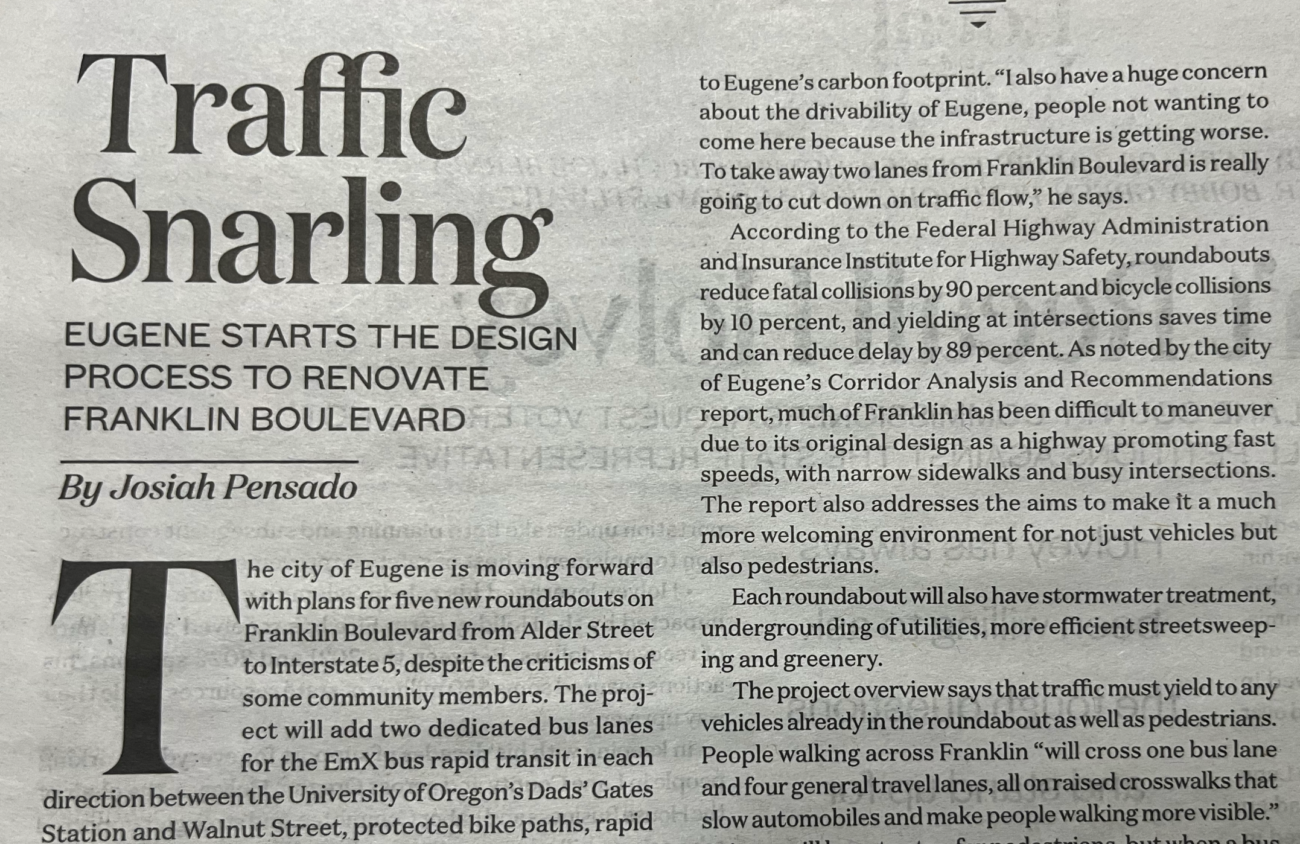The city of Eugene is moving forward with plans for five new roundabouts on Franklin Boulevard from Alder Street to Interstate 5, despite the criticisms of some community members. The project will add two dedicated bus lanes for the EmX bus rapid transit in each direction between the University of Oregon’s Dads’ Gates Station and Walnut Street, protected bike paths, rapid flashing beacons for pedestrians, wider sidewalks and roundabouts to help ease traffic.
Hirons Pharmacy owner John Hiron’s main critique of the project is the removal of the left turn lane from Franklin Boulevard onto Orchard Street. He says it makes him worried about the state of the pharmacy’s operations, as well as how the new traffic systems will send more congestion into the East Campus neighborhood. Hiron took out a full page ad in the June 29 issue of Eugene Weekly critiquing the project.
Rob Inerfeld, the city’s transportation planning manager, says that despite the criticisms, Hiron and he have “a good relationship where we can talk to each other.”
Stadium Automotive and Euro-Asian Automotive owner George Rode says his qualms with the project lie with the environmental concerns of the new design, saying that having that many cars idling and slowing down will add to Eugene’s carbon footprint. “I also have a huge concern about the drivability of Eugene, people not wanting to come here because the infrastructure is getting worse. To take away two lanes from Franklin Boulevard is really going to cut down on traffic flow,” he says.
According to the Federal Highway Administration and Insurance Institute for Highway Safety, roundabouts reduce fatal collisions by 90 percent and bicycle collisions by 10 percent, and yielding at intersections saves time and can reduce delay by 89 percent. As noted by the city of Eugene’s Corridor Analysis and Recommendations report, much of Franklin has been difficult to maneuver due to its original design as a highway promoting fast speeds, with narrow sidewalks and busy intersections. The report also addresses the aims to make it a much more welcoming environment for not just vehicles but also pedestrians.
Each roundabout will also have stormwater treatment, undergrounding of utilities, more efficient streetsweeping and greenery.
The project overview says that traffic must yield to any vehicles already in the roundabout as well as pedestrians. People walking across Franklin “will cross one bus lane and four general travel lanes, all on raised crosswalks that slow automobiles and make people walking more visible.” Drivers will have to stop for pedestrians, but when a bus passes, pedestrians must stop. Pedestrians will also have access to a rapid flashing beacon to ensure visibility for drivers. Cyclists will follow the same counter clockwise traffic flow. Cyclists “will need to look for yielding drivers when crossing side streets and Franklin in the same way that people walking will,” the project overview notes.
Concept development occurred from 2019 to 2020, with an open house at the Joe Romania Building on May 29, 2019, to receive community feedback. The project team then showcased a draft at the Ford Alumni Center on March 10, 2020. From 2020 to 2021, Eugene partnered with Springfield to apply for the RAISE grant, which will cover $19 million of the $21 million used to complete this renovation. Springfield has also used these funds to transform its respective portions of Franklin. According to the Oregon Department of Transportation, the estimated cost of the project through its construction would be upward of $31.48 million. In 2019, Springfield completed its first phase of construction on Franklin.
Currently, transportation planners are refining the project to gain approval under the Environmental Protection Agency’s NEPA requirements. “Our project is relatively low impact in that we’re not expanding the footprint of the right of way in the street by very much, so it’s a pretty straight forward legal process,” says Inerfeld, the city transportation planning manager..
The design engineering phase is where the project managers expect to do any sort of brushing up to the plan. As well as the NEPA analysis, Eugene has done its corridor analysis report, which aims to weigh the pros and cons of the project, as well as any other recommended design concepts
Better Eugene-Springfield Transportation (BEST), a nonprofit dedicated to improving infrastructure for transportation, conducted community outreach through a $10,000 grant from the American Public Transportation Association.
BEST has had a survey open to the University of Oregon students, residents and local businesses. When BEST goes to the UO campus and asks students whether they know that Franklin will be renovated, most students do not. Rob Zako, executive director of BEST, says the group has received 288 responses to an online survey. He says, “In general, at first glance, what we’re seeing is that students are not satisfied with the way Franklin Boulevard is now.” Zako adds that he believes that community engagement is difficult for students because there is a lack of a daily paper and low general interest in the project as well.
Once the design engineering is complete, the design construction on Franklin will start as early as 2024 or 2026, and will be completed by 2028. Detours and other access routes will be present to ensure that Franklin will not be closed during this time. ν
